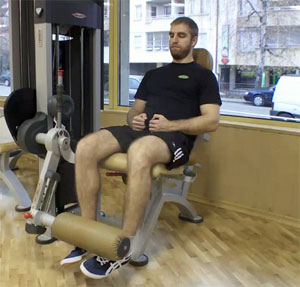Thigh extension is an isolated simple exercise that trains the hip extensors on the knees. It is performed on specialized machines. The brand is irrelevant here. Its implementation does not require prior experience, but only instruction to set up the training machine.
Contraindications
People with knee injuries, whether joints, ligaments or muscles, should be careful when choosing a weight to perform.
Participating muscles
Dynamists
- Quadriceps femoris
Synergists
There are no synergists, the movement is isolated.
Extras and dynamic stabilizers
- Adductors, in versions with accent
- Wrist flexors
- Rectus abdominis
- Long spinal muscles (Erector spinae)
- Others – this includes a wide group of muscles that help stabilize the body to the machine, depending on where its handles are attached.
According to the sequence
- Unilateral (with only one leg) – this performance allows you to concentrate entirely on the working muscle of one leg. Here the whole series is performed unilaterally. The application of the variant is limited and serves mainly to overcome the difference in strength / mass of the two thighs in case of imbalance.
- Bilateral (with both feet at the same time) – this is the most popular option. In addition to allowing you to work with the highest weight, the bilateral performance offers the opportunity to compare the strength and fatigue sensations of the left and right quadriceps.
- Consecutively – in the sequential unfolding you perform one repetition with one leg, then one repetition with the other leg and so on – until the end of the series. This option is used to reduce fatigue and allows longer series. It is used for more strength endurance in the quadriceps. Allows better glycogen depletion with less synthesized lactic acid. Preferred by bodybuilding enthusiasts.
You can order steroids for sale from our online anabolic steroid shop.
According to the accent
- Outer heads (Vastus lateralis) – the knees and ankles are the width of the pelvis throughout the amplitude of movement. The feet and knees are slightly turned inwards.
- Inner heads (Vastus medialis) – the knees and ankles are the width of the pelvis throughout the range of motion. The feet and knees are slightly turned outwards.
- Neutral – with even load distribution. The knees and ankles are the width of the pelvis throughout the range of motion. The steps point upwards – neither outwards nor inwards.
Preparation and implementation
- Adjust the appliance to your height and the length of your legs.
- Choose a weight, sit comfortably and choose a position for your legs.
- Grasp the handles and tighten the torso muscles.
- Lift the weight by starting to spread your legs.
- Hold at the point of maximum load.
- Lower in a controlled manner.
- Repeat until the end of the series.
Recommendations
- Do not bend your legs at the knees to the maximum position. Leave a little but enough space between the pads for your calves so that when you release the weight, your thighs have a point of rest. In addition, it would protect your joints in the event of a sudden drop in the lowest point of the movement.
- Do not bend your knees during the series, keep them parallel.
- If you do not have a backrest, try not to swing your body during the exercise.
- If you have a backrest, do not detach your body from it during the exercise.
Fitness and bodybuilding enthusiasts can include thigh extensions after basic exercises. The third or fourth exercise of the thigh training is the usual place for the stretches, when the goal is to increase muscle mass and strength in the quadriceps.
Fans of conditioning programs can take advantage of the insulating nature of hip extension to overcome bilateral muscle imbalance, or to strengthen the quadriceps in the event that there is a power imbalance between the flexors and extensors of the same leg.

